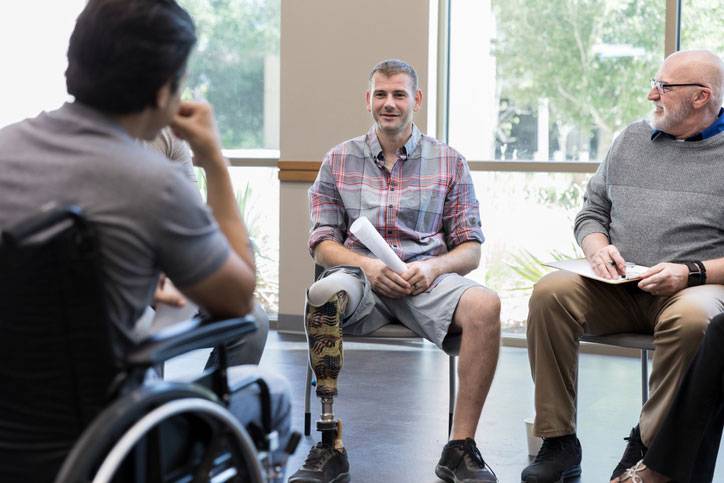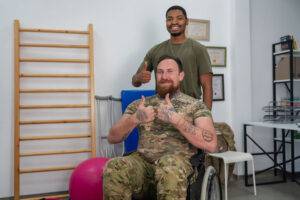
The appearance of U.S. Department of Defense (DoD) visual information does not imply or constitute DoD endorsement.
The US military goes to great lengths to protect forces in garrison and in the field.
We’re talking about an organization that spent millions developing new camouflage uniforms with Near Infrared Signature masking and digital patterns that can render you invisible in any biosphere on the planet—and then insists you put a bright reflective PT belt over the top as a safety measure to make sure you can be seen at night and during pre-dawn hours.
Even with every precaution in place to ensure the safety of those in uniform, there is no way around the fact that military service is a risky business. Service members put themselves in harm’s way in defense of buddies, country, and loved ones. Sometimes that kind of bravery has terrible consequences.
They may have to wear those scars for the rest of their lives, but those brave souls are never forgotten.
Disabled veterans are owed a debt by their country. The Department of Veterans Affairs is here to pay up.
The largest part of the Veterans Affairs budget is dedicated to the health and welfare of veterans. In 2023, that will come to more than $118 billion of the $200 billion annually spent on veteran health and education.
Military disability benefits are not usually directly aimed at education. Any service member getting disability almost certainly qualifies and can use their existing GI Bill® benefits for school.
But VA disability support programs can still play a role in making your education possible.
Explore Your Military Training and Degree Options
Disabled Vets Get Fast-Tracked for Regular Veteran Educational Benefits
 The main way that the VA kicks in to help disabled veterans get an education is by fast-tracking eligibility for the already-generous vet education benefits they offer.
The main way that the VA kicks in to help disabled veterans get an education is by fast-tracking eligibility for the already-generous vet education benefits they offer.
For the main GI Bill® in use today, Chapter 33, known as the Post-9/11 GI Bill®, most service members have to get through at least 90 days on active duty to receive any benefits. Even then, they don’t get full benefits unless they finish a complete three years of service.
If you were wounded in action, the standard requirements don’t apply: a Purple Heart means you’re instantly eligible for full benefits without meeting any further requirements.
Even if you were injured in training or some other active duty mishap, as long as you have at least 30 days behind you, you can receive full Chapter 33 benefits.
And those benefits are pretty amazing, fully covering your in-state tuition at a public university, paying for housing, even kicking in for books and supplies.
Of course, your discharge has to be honorable.
The Yellow Ribbon Program is a partnership between the VA and schools that volunteer to help pay the difference between GI Bill® limits and the higher tuition rates found at private schools. Eligibility basically mirrors Chapter 33 requirements. If you have a Purple Heart or service-related disability when discharged, you can also qualify for full Yellow Ribbon benefits.
The Montgomery GI Bill® Also Offers Some Extra Flexibility To Disabled Veterans
Even the older GI Bill® program, though, Chapter 30, or the Montgomery GI Bill®, offers some provision for disabled vets. MGIB is more complicated in general, with separate rules for active duty (MGIB-AD) and National Guard or reservists (MGIB-SR).
How MGIB-AD Helps Disabled Vets
MGIB-AD requires that you pay in at least $1,200 while you’re still on active duty, and serve for at least 3 years (or two if that was in your initial contract). There’s no exception to either of those requirements, even for wounded or disabled service members.
But there is still some extras for vets on disability. Normally you only get ten years to use your MGIB-AD benefits. But if you are unable to go to school due to illness or disability, that time is extended. And in some ways, this is even better than the Post-9/11 rules, because the illness or disability doesn’t have to be service related. Even if something happened to you after discharge, you’re covered.
How MGIB-SR Supports Disabled Reservists
MGIB-SR is different in that it can only be used while you are still in the reserves. But again, there is an exemption for disabled vets. If you were separated for disability reasons, you can continue to use your MGIB-SR benefits.
Both Montgomery GI Bill® programs (MGIB-AD and MGIB-SR) offer just a flat monthly payment toward your education. But that’s still a big deal in paying for college these days!
Normally you have to pick either MGIB or the Post-9/11 benefits if you happen to be eligible for both. The rules around disability might make it easier for you to pick one or the other, though, considering when and how you were injured.
You can read more about your GI Bill® benefits here.
VA Disability Benefits Cover Cost of Living Expenses While You Earn a Degree
 VA disability compensation isn’t attached to your educational goals at all. It’s something you are owed for your service, a way to take care of you after discharge in return for the sacrifices you made for your country.
VA disability compensation isn’t attached to your educational goals at all. It’s something you are owed for your service, a way to take care of you after discharge in return for the sacrifices you made for your country.
But that doesn’t mean that disability benefits aren’t useful for education. In fact, you are allowed to use that money to pay for everything you need.
Determining Eligibility for VA Disability Benefits
Determining eligibility for, and the amount of, VA disability benefits is a hugely complicated subject that deserves its own website. But the general terms are pretty clear:
FIRST
- You must have a current illness or injury, either mental or physical
AND - You served on active duty, or inactive duty for training
NEXT
- You must have gotten sick or injured while serving, and can establish a clear connection between your current disability and that service-related injury or sickness
AND - You had a previously existing condition before joining the military, which military service made worse
OR - You have a disability related to your active duty service that only got diagnosed after you had already been discharged
Service member discharged for reasons other than honorable may or may not be eligible for disability; it will depend on the details of the case.
You can apply directly on the VA website to receive these benefits.
Your VA Disability Rating Will Determine Many of Your Benefit Options
All kinds of different conditions are covered. Basically, anything bad that has lasting effects that was a result of your service is probably covered. Some of the most common qualifications include:
- Severe hearing loss
- Lung conditions
- Ulcers
- Cancer
- Traumatic Brain Injury (TBI)
- Post-traumatic Stress Disorder
- Anxiety
- Depression
Of course, many veterans, especially those who served in combat, have a cocktail of these conditions. These all go into the mix when the VA assigns you a disability rating.
The disability rating is just a percentage that represents how severely your disability affects you. In other words, if you have hearing loss that your doctor estimates impairs your normal hearing by ten percent—you’d get a ten percent disability rating for that.
Other conditions you have on top of that also get factored in. The VA looks at your overall function, though, so you’ll never get a combination that adds up to more than 100 percent.
You may also receive additional benefits if you have dependents, particularly if one or more of those dependents also has disabilities, regardless of the cause.
How Military Disability and College Benefits Can Work Together for Your Education
 In most cases, a vet eligible for disability is also going to be eligible for direct VA education benefits. It’s always going to be best to tap into those programs first, since they can only go toward education anyway while your disability can be used for anything.
In most cases, a vet eligible for disability is also going to be eligible for direct VA education benefits. It’s always going to be best to tap into those programs first, since they can only go toward education anyway while your disability can be used for anything.
But you might choose to use your disability pay to augment your GI Bill® benefits. Your disability payments come in monthly and are tax-free. That means using them toward education-related expenses is still a far better option than taking out loans if your other benefits come up short.
While basic VA disability comes as a monthly cash payment, there are also certain types of disability support to help you with certain other needs. Again, while they aren’t specifically directed at helping you get an education, they can sure help!
Military Disability Housing Assistance Benefits Make Sure You Have a Place To Live While in College
The best-known VA housing assistance program is for low-interest loans that help you buy a house or refinance. That isn’t a big help for going to college in most cases, since you may not be permanently located near where you go to school.
But disabled veterans also have a housing assistance option that can be applied to temporary homes. These grants come through two programs:
Specially Adapted Housing
A service-connected disability with mobility or visual impairment can entitle you to up to $40,983 (as of 2022) in order to make changes to a temporary residence to better accommodate living and studying with your injuries.
Special Home Adaptation
A service-connected disability that resulted in the loss of use of both hands, severe burns, or certain respiratory or breathing injuries can allow you to receive up to $7,318 (for 2022) to retrofit a temporary residence to allow you to live more independently.
Both of these one-time grants can give you tools to change up your residence to make life easier during college.
The big caveat to both these programs is that, while you do not need to own or plan to make your residence a permanent home, it must be a family member’s home. The VA obviously isn’t going to pay to refit a dorm room you are only going to be in a couple of years. But this is still a great benefit if you are living with your parents or other family members while attending school.
Military Disability Auto Allowances Can Get You to and From Class
 A special benefit automobile allowance offering a one-time payment of just over $22,000 in 2022 is available if your disability prevents you from driving a regular car. This money goes towards helping you buy or outfit a specially equipped vehicle that gives you mobility despite your disability.
A special benefit automobile allowance offering a one-time payment of just over $22,000 in 2022 is available if your disability prevents you from driving a regular car. This money goes towards helping you buy or outfit a specially equipped vehicle that gives you mobility despite your disability.
Clearly, this benefit can be a big help if you are attending classes in person and need to commute to your college regularly.
Military Disability Healthcare Keeps You Fit for School
The Veterans Health Administration (VHA) is dedicated to providing healthcare for veterans in every phase of life. That includes those attending university.
With nearly 1,300 VHA healthcare facilities nationwide, chances are your college will be near at least one, allowing you to easily access the services you need.
Keeping yourself in the best condition possible to pay attention and learn is a critical part of your college experience. Disabilities are distracting, there is no question about it. Whether it’s anxiety that strikes when you walk into a narrow hallway without hard cover, or brain injuries that make it tough to concentrate for long enough to get through even a paragraph of a textbook, there’s a lot of challenges that other college students don’t have to deal with.
VHA services are there to help you get the best possible treatment for whatever is impacting your life and learning experience.
Most Disabled Veterans are Eligible for VHA Services
Most veterans who enlisted for active duty service after 1980 have to have gone through at least two years of continuous service to be eligible for VA health benefits. But if you were separated for disability, or given a hardship discharge, you automatically qualify.
Members of the reserves or National Guard must have been called to active duty for purposes other than training in order to qualify for VA healthcare benefits.
Discharges other than honorable may also disqualify you, but not always.
Depending on your length of service, you might also qualify to keep certain TRICARE benefits on top of VA healthcare. And even if you aren’t qualified by discharge for disability reasons, there are certain classes of need that can still receive free treatment through the VA, including:
- PTSD
- Mental health issues
- Military sexual trauma
There are big demands on the VA system and a lot of veterans to take care of. So you will be assigned a priority group that will affect how soon and how much care you receive. These are generally based on your level of disability, with the worst first, just like CASEVAC cases.
The VA website makes it easy to apply online to receive healthcare services.
Veteran Readiness and Employment Offers Military Disability Benefits To Get You Back to Work
 VR&E, also known as Chapter 31, is designed to help disabled veterans explore employment options and fill training and education needs.
VR&E, also known as Chapter 31, is designed to help disabled veterans explore employment options and fill training and education needs.
This program used to be called the Vocational Rehabilitation and Employment program, which gives you some idea about its priorities. It’s aimed at getting you back to work in situations where your disability limits or prevents that.
The reason for the name change is tied in with the range of post-discharge job training veterans are exploring today as well as the kinds of disabilities they are suffering. At one time, hands-on, blue-collar occupations were where many vets were headed after the service, and physical rehabilitation for service-connected injuries to hands, arms, and legs allowed them to get back to work.
Today’s battlefield still brings plenty of physical damage, but also increasing amounts of traumatic brain injury and psychological trauma. And the job market has changed as well, requiring advanced training and college coursework even for jobs that used to be entirely blue-collar.
VR&E today supports your professional as well as vocational goals through five different tracks:
- Reemployment - If you had a civilian job before deployment, this track works to get you back into that position.
- Rapid Access to Employment - If you have existing skills that are useful in the civilian job market, this track looks for placements to get you into a matching position.
- Self-Employment - If you are interested in starting your own business, this track helps direct you to the right resources to make that happen.
- Employment Through Long-Term Services - If you will need a more advanced or lengthy education to get through your disability and return to the job market, this track offers support along the way.
- Independent Living - For disabled vets who are unable to return to work immediately, VR&E offers this track to at least ensure you are able to live independently while you recover or retrain.
As a practical matter, the last two of those tracks offer the most assistance in college-level education. You are capped at 48 months of full-time services except in exceptional circumstances.
There is no limitation on when you can apply to VR&E or when you can use the benefits as long as your discharge date was on or after January 1, 2013. Individuals discharged prior to that have 12 years from that date, or from the date they first received their disability rating.
Untangling Your VR&E and GI Bill Educational Benefits
 It used to be the case that using VR&E benefits would also eat into your GI Bill limits — each month of VR&E would come out of your number of available months of GI Bill education benefits.
It used to be the case that using VR&E benefits would also eat into your GI Bill limits — each month of VR&E would come out of your number of available months of GI Bill education benefits.
In 2021, that changed. Through a combination of court rulings and internal reinterpretations of existing rules, the VA decided that vets who were eligible for multiple educational support programs (usually Chapter 33 and 30 benefits) could use up to 48 months, total… even though each of those programs, by itself, was only good for 36 months.
In practice, this gave students an extension, where they could tap into the second program for an additional year of schooling.
Since VR&E was one of those programs, that meant using it would take away from your GI Bill eligibility. But with the reshuffling, VA decided not to count VR&E against those 48 months at all. So, if you were disabled and otherwise eligible for all three, you could use the full 48 months of VR&E, followed by 36 months of Chapter 33, followed by 12 months of Chapter 30.
There’s still a catch, though—while VR&E no longer counts against GI Bill benefits, the opposite is not true. If you use the GI Bill benefits you are entitled to, it will eat into VR&E eligibility. This means that if you are eligible for both, you’ll want to use VR&E first, to leave your GI Bill options intact for later.
Determining Eligibility for VR&E Benefits
Your eligibility for VR&E hinges on your level of rated disability. You must be:
- Honorably discharged from the service
- Rated at least 20 percent disabled by the VA
OR - Rated at least 10 percent disabled with a severe employment handicap
VR&E is primarily an employment program, not an educational program.
It’s important to remember that although VR&E offers excellent education benefits for disabled veterans, it also comes with limitations.
It’s not directly tied to your disability—instead, it only applies in as much as your specific disability impacts your ability to work. So if, for example, you were a qualified accounting professional before you joined up, and lost the use of your legs on active duty, VR&E doesn’t have a lot to offer you in educational terms—you’re still qualified and equipped for that work. The program would help you find a job, but not send you back to school for retraining.
All the college training you pursue through VR&E also hinges on the goals set together with your VRC counselor. They have to review and agree that your coursework is going toward that objective. So you aren’t as free to pick your own path as you are with other programs.
VR&E Benefits That Apply Toward a University Education
If your education plan is approved, tuition and fees will be paid directly to the school, covering 100 percent up to $35,000 per year—more generous than GI Bill® benefits. The Yellow Ribbon Program, however, which tops up spending to match more expensive private schools or for out-of-state tuition, isn’t open to VR&E recipients, so if you go over $35K, you’re on the hook.
Books and supplies are also 100 percent covered under VR&E.
Although VR&E doesn’t have a specific housing allowance, it can include a Subsistence Allowance Stipend (SAS) that you can use toward housing or other costs of living. It’s similar in concept to the MHA (Monthly Housing Allowance) in the Post-9/11 GI Bill®. In fact, if you have Chapter 33 eligibility left, you’re allowed to choose the MHA in preference to SAS—it is usually more generous.
Unlike MHA, SAS isn’t based on location. Instead, the amount is determined by a combination of:
- The type of training you are going through, whether institutional, on-the-job, apprenticeship, or some combination
- Whether your training is full or part-time, in 25 percent increments
- How many dependents you have
SAS levels are adjusted annually. The maximum monthly rate for 2022 was $2,838.19.
VR&E Employment Through Long-Term Services Track
The ETLTS VR&E track benefit is the one most closely aligned with the educational needs of disabled vets.
Just like the old Montgomery and Post-9/11 GI Bill® rule prior to 2022, you must choose between the GI Bill® and the VR&E ETLTS track—you cannot use both simultaneously even if you are eligible for both.
Unlike GI Bill® education benefits, which are open to any veteran who qualifies for any purpose, ETLTS is intended for very specific circumstances: assisting disabled veterans whose disability is itself an obstacle to getting training and education to qualify you for a job.
But that also makes ETLTS less flexible than general GI Bill® benefits. You must have previously identified a specific occupational goal or cluster and your coursework has to be toward that goal. There’s no option for seeing what you enjoy and declaring a major later on.
You’re also on the clock—you will have an anticipated completion date by which your VRC will expect you to finish the program. If not, your support may be reevaluated.
VR&E Independent Living Services Track
Another important track in VR&E for disabled vets who are pursuing an education is the independent living services track. This is designed to assist veterans unable to immediately return to employment and who are in need of services to assist with living independently.
A vocational rehabilitation counselor is assigned to help you evaluate your needs and plan for your goals. The VRC can refer you to support resources and determine if you are eligible for a home adaptation grant. This can help you make changes in your residence to make it more accessible for your needs—an important consideration for your studies.
ILS services are typically about two years in length, but can be extended in some cases.
The VetSuccess on Campus Program Eases Your Transition to College Life
 The VA’s VetSuccess on Campus (VSOC) program is available to any veteran who is receiving educational benefits through the VA, not only those who are disabled. Counselors offer a wide range of advice and information, all designed to support a transition from military to civilian life. They are there to make your experience on campus one that will benefit your life going forward.
The VA’s VetSuccess on Campus (VSOC) program is available to any veteran who is receiving educational benefits through the VA, not only those who are disabled. Counselors offer a wide range of advice and information, all designed to support a transition from military to civilian life. They are there to make your experience on campus one that will benefit your life going forward.
That includes services such as career counseling or vocational testing. But for disabled vets going to school, there are two other critical roles that VSOC counselors fill:
Making referrals to VA or campus healthcare resources – Ongoing disability comes with ongoing health challenges. Both the VA healthcare system and university clinic resources can help with treatment for either chronic or acute issues that come up. VSOC counselors know exactly where to point you to get the help you need when it happens.
Arranging for disability accommodations in or out of the classroom to support your studies – These can be as simple as making arrangements to have assistive listening devices provided in classrooms for hearing impairments, or as in-depth as getting a helper to take notes and help with writing assignments for vets with hand injuries.
VSOC counselors are currently available at 104 colleges across the country. Since the program only launched in 2009, you can expect it to continue to expand. Keep checking your school to see if they have joined, or contact the VA VR&E Outreach Team to request a counselor for your campus.
VA Caregiver Support Services May Pay a Caregiver to Assist You While You Are Attending School
 Unlike VetSuccess resources, the VA Caregiver programs aren’t specific to educational needs. In fact, caregivers might not specifically address any of your school work.
Unlike VetSuccess resources, the VA Caregiver programs aren’t specific to educational needs. In fact, caregivers might not specifically address any of your school work.
But if you are more than 70 percent disabled, you could be eligible to have VA payment for a personal caregiver who can assist you with your daily living challenges as you are attending school.
Now, to be honest, there are probably relatively few vets with 70 percent disability or higher who are also taking on the challenges of university. But people who join the American military don’t give up easily. You deserve a full life with the same educational opportunities as any American, regardless of the price you paid for your service.
So, if some basic home health and support needs are the only thing standing between you and a degree you are dreaming of, this program can help.
Determining Eligibility for VA Caregiver Benefits
Disabled vets can qualify to have up to one primary and two secondary family caregivers.
For the Veteran:
- You must be enrolled in VA health care
- You must have a 70 percent or higher VA disability rating
- Have served on active duty on or after September 11, 2001, or prior to May 7, 1975
- Be discharged or have a discharge date
- Require at least 6 months of continuous, in-person personal care services
For the Caregiver:
- Must be at least 18 years of age
AND - Either a child, stepchild, spouse, parent, or extended family member of the veteran
OR - Be a person living full-time with the veteran
There is also a general caregiver support program, with less stringent qualifications. But it does not offer financial supports.
Caregiver Benefits for Disabled Veterans Earning Degrees
 Primary caregivers in this program receive a monthly stipend. The amount is pegged to the government’s General Schedule pay rates at Grade 4, Step 1, adjusted for local rates. For 2022, the base rate at that level came to $2,315.16. Caregivers for veterans who are able to self-sustain in their community have a bit shaved off of that amount.
Primary caregivers in this program receive a monthly stipend. The amount is pegged to the government’s General Schedule pay rates at Grade 4, Step 1, adjusted for local rates. For 2022, the base rate at that level came to $2,315.16. Caregivers for veterans who are able to self-sustain in their community have a bit shaved off of that amount.
Caregivers also have access to health insurance through the Civilian Health and Medical Program of the Department of Veterans Affairs (CHAMPVA). They may receive mental health counseling to support them in their role, and can receive travel benefits when traveling with you to appointments. And they can get up to 30 days off, during which the VA will pay for another provider to come in and take over.
Millions of disabled American veterans have come home from honorable service to find that the VA has their back. The Greatest Generation fought through lasting injuries and trauma to build new business, invent incredible technologies, and forge the greatest nation on Earth.
There’s no reason you can’t apply your military disability benefits to build the same kind of meaningful and fulfilling life.





